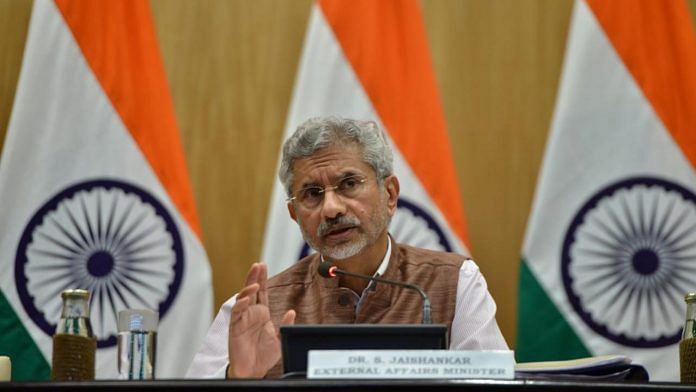New Delhi: External Affairs Minister S. Jaishankar’s American think tank blitz has left US academics and policy wonks bickering on Twitter. While the debate began with the utility of Jaishankar’s multiple speeches, it soon morphed into discussions about Article 370 and its revocation.
‘Full Jaishankar’
Jaishankar, running a tight schedule, spoke at seven of the most prestigious think tanks in New York and Washington DC. He spent his time relentlessly making India’s case in Kashmir and more generally, articulating India’s “approach to foreign policy”.
Milan Vaishnav, Senior Fellow at Carnegie Endowment, Washington, called Jaishankar’s think tank appearances as “The Full Jaishankar” – “also known as hitting up 7 think tanks in 7 days in both DC and NY, sets a new benchmark,” tweeted Vaishanav.
According to a report in Times of India, “In American TV business, the term Full Ginsburg refers to an appearance by one person on all five major Sunday morning talk shows on the same day.” Ginsburg was Monica Lewinsky’s lawyer during the Bill Clinton scandal.
The debate
The debate was sparked after a few academics praised Jaishankar for an effective performance in the US think-tank circuit.
“I don’t recall a foreign minister — or any foreign official for that matter — working the town so comprehensively and effectively as @DrSJaishankar has this week. Nobody in DC should be left uncertain about India’s worldview and policy priorities,” tweeted Peter Lavoy, former high-ranking US security official and academic.
However, his analysis was questioned by Vipin Narang, a professor at MIT.
“But who is he trying to convince, and of what? DC ThinkTank world is an audience incredibly friendly to India to begin with,” tweeted Narang. He went on say that it’s the White House that needed the convincing, not DC think tanks.
Soon, a flurry of scholar’s sided with Lavoy’s arguments.
Seema Sirohi, a Washington based columnist for The Economic Times tweeted: “India’s messaging over the years has left a lot to be desired. Western reporters are badly informed or lazy or… worse.”
Kunal Singh, a PhD candidate at MIT who was formerly with Hindustan Times, also agreed with Lavoy: “I think this [full Jaishankar] was very much required. American friends tell me that former Pakistani army officers are always buzzing around DC think tank events and conferences, and Indians are generally nowhere to be seen.”
Brookings India’s fellow, Constantino Xavier disagreed and said, “That’s outdated info about DC. Some of those Pakistani think-tank-buzzing “army officers” ended up in prison… And India significantly upgraded its own outreach over the years I was there (2009-16).”
Steve Herman, a journalist with Voice of America, also praised the Indian Ambassador to the US for arranging a “(Jaishankar’s) lunch with a group of DC journalists in which he was direct and forthcoming — and it was a ‘pen and pad’ on the record.”
Meanwhile, Tanvi Madan, Senior Fellow at the Brookings Institution, tried to put the “full Jaishankar” in a more strategic perspective and said, “I can see why folks are assessing this from an India-Pakistan prism, but I actually think there’s been more focus in these comments on India’s approach to foreign policy, partnerships, etc – and there’s some interesting stuff to sift through there.”
The digression
The discussion, however, soon turned away from the utility of ‘full Jaishankar’ to Article 370 and its original status.
“Very few people in the US know that Art 370 was temporary and it allowed discriminatory provisions. Even in think tanks and media houses,” tweeted Kunal Singh.
Christopher Clary, professor at University of Albany strongly disagreed with Singh and tweeted: “C’mon. Sheikh Abdullah negotiated 370 in order to permit autonomy, & could have put an expiry date if he wanted to do so. It was negotiated to keep open possibility J&K might leave India _or_ get closer to it. It was not written so that Delhi could get rid of autonomy whenever.”
Paul Staniland, a professor at University of Chicago, stepped in and tried to provide a more sober analysis. “The problem India faces on Kashmir is the message, not the messenger. Locking up politicians and turning off mobile phones for months, for instance, are just simply not a good look.”




Nice overview of opinions there.
The problem is the message, indeed. While Jaishankar had to defend Art 370 – and he did a good job of doing it – the fact is that it is bad policy that looks bad. Humiliation and inhumane treatment of citizens cannot lead to good results – how much ever you rationalise it.
Prof. Vipin Narang is a known India baiter. There have been innumerable instances in the past when he has danced to the tune of the ISI propaganda machinery and has levelled wild and baseless allegations against the Indian govt and its ministers. He is well known for being highly critical (to the point of absurdity) of India while exculpating Pakistan of all charges.
Prof Narang’s criticism of Art 370 revocation is valid. In any case, your response is ad hominem – directed against a person rather than the position they are maintaining. That is usually not a valid way of arguing. Just saying!
Western reporters are badly informed, lazy or worse … One wonders how Ms Seema Sirohi would describe our own Pulitzer Prize winning crowd.